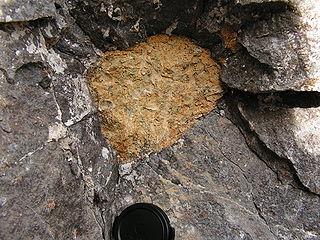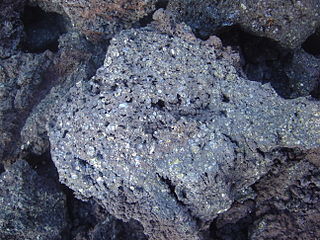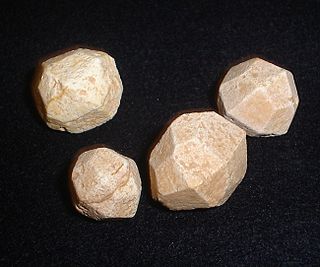
Gabbro is a phaneritic, mafic intrusive igneous rock formed from the slow cooling magma into a holocrystalline mass deep beneath the Earth's surface. Slow-cooling, coarse-grained gabbro is chemically equivalent to rapid-cooling, fine-grained basalt. Much of the Earth's oceanic crust is made of gabbro, formed at mid-ocean ridges. Gabbro is also found as plutons associated with continental volcanism. Due to its variant nature, the term gabbro may be applied loosely to a wide range of intrusive rocks, many of which are merely "gabbroic". By rough analogy, gabbro is to basalt as granite is to rhyolite.

Basalt is an aphanitic (fine-grained) extrusive igneous rock formed from the rapid cooling of low-viscosity lava rich in magnesium and iron exposed at or very near the surface of a rocky planet or moon. More than 90% of all volcanic rock on Earth is basalt. Rapid-cooling, fine-grained basalt is chemically equivalent to slow-cooling, coarse-grained gabbro. The eruption of basalt lava is observed by geologists at about 20 volcanoes per year. Basalt is also an important rock type on other planetary bodies in the Solar System. For example, the bulk of the plains of Venus, which cover ~80% of the surface, are basaltic; the lunar maria are plains of flood-basaltic lava flows; and basalt is a common rock on the surface of Mars.

Rhyolite is the most silica-rich of volcanic rocks. It is generally glassy or fine-grained (aphanitic) in texture, but may be porphyritic, containing larger mineral crystals (phenocrysts) in an otherwise fine-grained groundmass. The mineral assemblage is predominantly quartz, sanidine, and plagioclase. It is the extrusive equivalent of granite.

Dacite is a volcanic rock formed by rapid solidification of lava that is high in silica and low in alkali metal oxides. It has a fine-grained (aphanitic) to porphyritic texture and is intermediate in composition between andesite and rhyolite. It is composed predominantly of plagioclase feldspar and quartz.

Trachyte is an extrusive igneous rock composed mostly of alkali feldspar. It is usually light-colored and aphanitic (fine-grained), with minor amounts of mafic minerals, and is formed by the rapid cooling of lava enriched with silica and alkali metals. It is the volcanic equivalent of syenite.

Andesite is a volcanic rock of intermediate composition. In a general sense, it is the intermediate type between silica-poor basalt and silica-rich rhyolite. It is fine-grained (aphanitic) to porphyritic in texture, and is composed predominantly of sodium-rich plagioclase plus pyroxene or hornblende.

Basanite is an igneous, volcanic (extrusive) rock with aphanitic to porphyritic texture. It is composed mostly of feldspathoids, pyroxenes, olivine, and calcic plagioclase and forms from magma low in silica and enriched in alkali metal oxides that solidifies rapidly close to the Earth's surface.

Nephelinite is a fine-grained or aphanitic igneous rock made up almost entirely of nepheline and clinopyroxene. If olivine is present, the rock may be classified as an olivine nephelinite. Nephelinite is dark in color and may resemble basalt in hand specimen. However, basalt consists mostly of clinopyroxene (augite) and calcic plagioclase.

Nepheline syenite is a holocrystalline plutonic rock that consists largely of nepheline and alkali feldspar. The rocks are mostly pale colored, grey or pink, and in general appearance they are not unlike granites, but dark green varieties are also known. Phonolite is the fine-grained extrusive equivalent.

A phenocryst is an early forming, relatively large and usually conspicuous crystal distinctly larger than the grains of the rock groundmass of an igneous rock. Such rocks that have a distinct difference in the size of the crystals are called porphyries, and the adjective porphyritic is used to describe them. Phenocrysts often have euhedral forms, either due to early growth within a magma, or by post-emplacement recrystallization. Normally the term phenocryst is not used unless the crystals are directly observable, which is sometimes stated as greater than 0.5 mm (0.020 in) in diameter. Phenocrysts below this level, but still larger than the groundmass crystals, are termed microphenocrysts. Very large phenocrysts are termed megaphenocrysts. Some rocks contain both microphenocrysts and megaphenocrysts. In metamorphic rocks, crystals similar to phenocrysts are called porphyroblasts.

Lamprophyres are uncommon, small-volume ultrapotassic igneous rocks primarily occurring as dikes, lopoliths, laccoliths, stocks, and small intrusions. They are alkaline silica-undersaturated mafic or ultramafic rocks with high magnesium oxide, >3% potassium oxide, high sodium oxide, and high nickel and chromium.

Essexite, also called nepheline monzogabbro, is a dark gray or black holocrystalline plutonic igneous rock. Its name is derived from the type locality in Essex County, Massachusetts, in the United States.
Theralite is, in petrology, the name given to calcic foidal gabbro, a plutonic hylocrystalline rock consisting of augite, olivine, calcic plagioclase (labradorite), and nepheline, along with accessories including biotite, magnetite, ilmenite and analcime.

Picrite basalt or picrobasalt is a variety of high-magnesium olivine basalt that is very rich in the mineral olivine. It is dark with yellow-green olivine phenocrysts (20-50%) and black to dark brown pyroxene, mostly augite.

Leucitite or leucite rock is an igneous rock containing leucite. It is scarce, many countries such as England being entirely without them. However, they are of wide distribution, occurring in every quarter of the globe. Taken collectively, they exhibit a considerable variety of types and are of great interest petrographically. For the presence of this mineral it is necessary that the silica percentage of the rock should be low, since leucite is incompatible with free quartz and reacts with it to form potassium feldspar. Because it weathers rapidly, leucite is most common in lavas of recent and Tertiary age, which have a fair amount of potassium, or at any rate have potassium equal to or greater than sodium; if sodium is abundant nepheline occurs rather than leucite.
Hawaiite is an olivine basalt with a composition between alkali basalt and mugearite. It was first used as a name for some lavas found on the island of Hawaii.

Igneous rock, or magmatic rock, is one of the three main rock types, the others being sedimentary and metamorphic. Igneous rocks are formed through the cooling and solidification of magma or lava.
São Tomé and Príncipe both formed within the past 30 million years due to volcanic activity in deep water along the Cameroon line. Long-running interactions with seawater and different eruption periods have generated a wide variety of different igneous and volcanic rocks on the islands with complex mineral assemblages.
The alkaline magma series is a chemically distinct range of magma compositions that describes the evolution of an alkaline mafic magma into a more evolved, silica-rich end member.
















